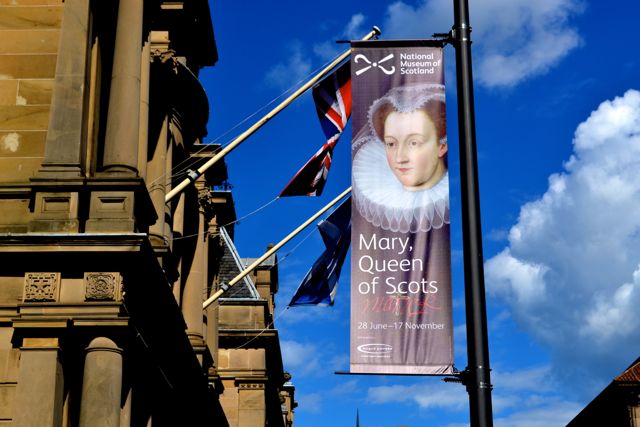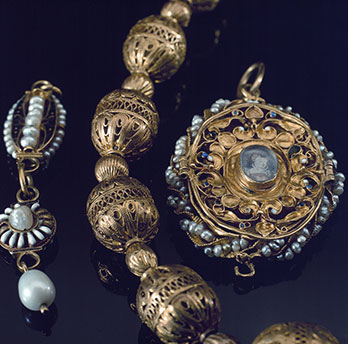Mary, Queen of Scots Returns to Edinburgh
In August 1561 Mary, Queen of Scots returned to Edinburgh from France as a Catholic queen in a newly reformed Protestant Scotland. Initially greeted with crowds curious to catch a glimpse of their new queen, Mary Stewart was regarded with suspicion and faced a volatile political situation from the fervent Protestant ascendancy.
450 years on, Mary has made a triumphant return to the Scottish capital in the form of an exclusive major exhibition currently on show at the National Museum of Scotland. Entitled Mary, Queen of Scots, the exhibition chronicles one of the most well-known and captivating royals of all time. It brings together jewels, furniture, tapestry, portraits and documents, providing an insightful view of a fascinating woman and the tumultuous era in which she lived.
Last week I attended a talk highlighting the exhibition’s star pieces by George Dalgliesh – Keeper of Scottish History and Archaeology at the National Museum for over 20 years. He explained that the 200+ items on display aim to present a slightly different view of Mary’s life, focusing on her personal rule in Scotland. He added that Mary still excites controversy to this day, with debates ensuing as to whether the Scottish queen was a Catholic martyr or a scheming adulteress.
On entrance to the exhibition the giant Blairs Memorial portrait of Mary towers over you, providing a commanding view of Mary on her way to the executioners block. Commissioned by Elizabeth Curle, a companion to Mary in the final years of her life, the portrait was painted 10-15 years after Mary’s death and was used as a piece of Catholic propaganda to promote Mary’s martyrdom. The portrait also includes visual vignettes of Mary’s grieving ladies in waiting and a scene from the execution.
The exhibition is set out chronologically, with the pinnacle point her reign as Queen of Scotland. Amongst the 16th century artifacts, which include a handwritten letter from Mary to her mother Mary of Guise, an innovative 21st century video shows a 3D image of what Mary would have looked like during her reign. Costume sketches and models by Jasper Conran for a recent production of Donizetti’s tragic opera Maria Stuarda show her renowned regal fashion sense and striking figure that continues to inspire artists today. Even John Knox, the leading light of protestant reformation is said to have described her features as “pleasing”.
Among the most fascinating of the items on display are the documents in the concluding section of the exhibition which include a set of cipher codes, the death warrant issued by Mary’s second cousin Elizabeth I, and a letter from Mary’s son James VI pleading Elizabeth for mercy. The original death warrant disappeared during the legal accusations following the execution, however the surviving copy on display was made for court records and includes the signature of Elizabeth I. The warrant instructs Elizabeth’s commissioners to:
“…repaire to our Castle of Fotheringhaye where the said Queene of Scottes is in custodie of our right trustie servant and Counsellor Sir Amyas Poulet Knight, and then taking her into your charge to cause by your commandment execution to be done upon her person.”
Today very little survives that belonged to Mary for a number of reasons. Following her death her belongings were burned to try and stop the creation of a cult of relics around a martyred Queen. Mary’s half-brother, James Stewart Earl of Moray, is also said to have sold his sister’s jewels following her abdication to pay for troops. A surviving relic on display are the Penicuik Jewels. Originally from a rosary, the jewels are now strung as a necklace and include a locket set with Scottish river pearls. Dalgleish thinks the jewels were probably commissioned by Mary to be given away, as they are not regal enough to be fit for a queen. Giving jewels as gifts was a common practice during the 16th Century as a way of binding a person to your cause.
To this day Mary continues to hold a place in Edinburgh’s heart, as buses make their way through the city’s streets with her face displayed on their sides. The exhibition provides a wondrous insight into the life of a controversial Queen whose legacy still lives on, almost 450 years after her death.
‘Mary, Queen of Scots’ runs until Sunday 17th November 2013. You can read more about the exhibition by clicking here.
Tagged















Its nice to read the history of my family name . Scotland is the most beautiful place on God’s earth to me god bless Scotland